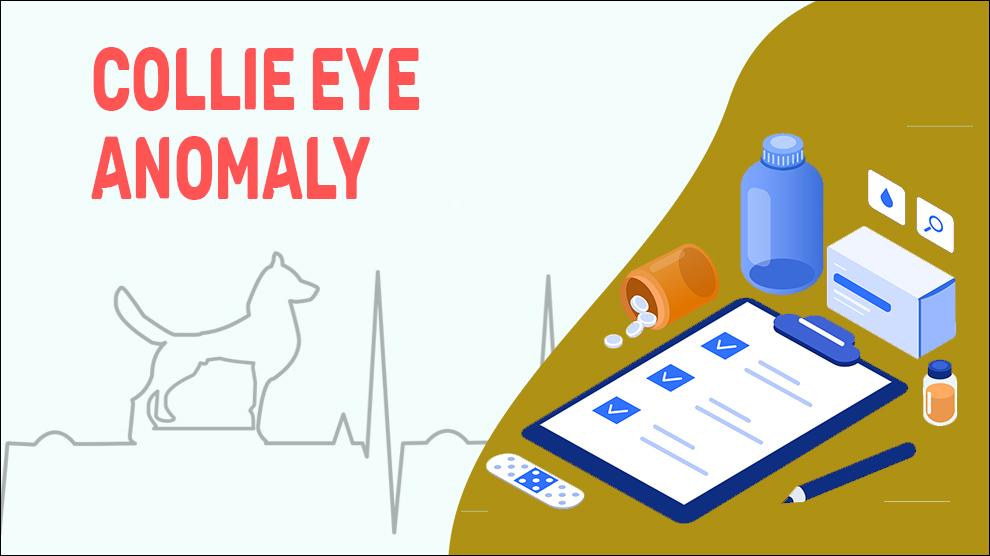Collie eye anomaly (CEA) is an inherited, non-progressive disease due to a mutation in the gene that determines the development of the eye causing heterogeneous signs and visual impairment.
Also known as collie eye, this disease was first described by Magrane in 1953. Collie eye anomaly typically results in the underdevelopment of the choroid ( the vascular layer of the eye located between the retina and sclera), retinal detachment, thinning of the sclera, and defect in the optic nerve. When it is really severe, this disease can lead to loss of sight as the retina becomes detached or there is no required blood flow.
All the Dogs affected by this disease have a 7.8 kb deletion located in the intron 4 of the non-homologous end-joining factor 1 (NHEJ1) gene (chromosome 37). This disease has autosomal recessive inheritance with incomplete penetrance of the causative gene. Nowadays, commercially available genetic tests are available to breeders and they can identify genetically affected dogs.
CEA is not a separate disease; it is often described as a syndrome. Blindness is the most common sign associated with CEA. Depending on the severity of the developmental defects, there is variation in the degree of loss of sight. Sometimes, many dogs have a normal vision if the severity of defects is less.
CEA may be associated with more obvious abnormalities in the eye that can be seen without special equipment. “Microphthalmia” describes eyeballs are not developed fully and are abnormally smaller. “Enophthalmia" describes eyeballs sunken backward deep into the bony eye sockets.
Symptoms Of Collie Eye Anomaly
- Microphthalmia - Small eyeballs than normal.
- Enophthalmia - Eyeballs sunken backward deep into the bony eye sockets.
- Bumping into things.
- Obstruction of the visual axis.
- Recurrent iritis
- Cataract
Treatment Options For Collie Eye Anomaly
- There are no treatments for congenital detachments and degeneration of the retina-associated detachments.
- Rhegmatogenous Detachment: Surgery that includes titanium tacking, vitrectomy, use of expandable gases, and Laser retinopexy.
- Cryosurgery: Usage of cold temperatures to destroy the damaged cell tissue.
Home Remedies For Collie Eye Anomaly
Always be aware of the risk factors associated with CEA. Educate yourself about the signs and symptoms.
Get suggestions from your vet regarding the prognosis of this condition.
Regularly monitor the symptoms and contact your vet if you note any significant new symptoms or changes in their vision.
Prevention Of Collie Eye Anomaly
CEA-CH DNA testing is available to check whether there is a CEA mutation. This is used to find out whether a dog is affected with CEA or clear of the mutation or an asymptomatic carrier of CEA.
Collie genetic testing is performed to look for the specific mutation that has happened in this breed or not.
When dogs are diagnosed with CEA, it is important to take measures to avoid breeding those dogs to remove CEA dogs from the gene pool.
Affected Breeds Of Collie Eye Anomaly
Border Collie, Smooth Collie, Australian Shepherd, Rough Collie, Shetland Sheepdog, Nova Scotia Duck Tolling Retriever
Additional Facts For Collie Eye Anomaly
- Causes:
This defect is congenital. This is a hereditary anomaly in the eye and affected dogs are born with the condition.
- Grades:
- Grade 1 - Retina has twisted vessels + negligible choroidal lesions.
- Grade 2 - Twisted retinal vessels + major areas of choroidal lesions.
- Grade 3 - Twisted retinal vessels + major areas of choroidal lesions + optic pits or holes.
- Grade 4 - Twisted retinal vessels + major areas of choroidal lesions + optic pits or holes + retinal detachment.
- Grade 5 - Twisted retinal vessels + major areas of choroidal lesions + optic pits or holes + retinal detachment + hemorrhage in retina.
- Mortality:
Collie eye anomaly is from birth or presents itself from puppyhood. The mortality rate is almost zero.
- Diagnosis:
- Complete blood count (CBC).
- Biochemical profile
- Ocular ultrasound
- ERG or Electroretinogram to check the dog’s vision.
- Prognosis:
The prognosis for dogs diagnosed with retinal detachment has never been better with today's medications available. Most dogs enjoy a pain-free life with careful attention and monitoring.
If the condition is not diagnosed earlier in the course of the disease or if it has progressed to deep detachment, the pet may lose its vision or may not respond fully to the treatment.
Other reasons for poor prognosis include congenital presentation, reduced visual acuity at presentation, big size (takes up more than 50% of anterior chamber), and opposition to cornea or lens.
When To See A Vet
When you first detect CEA in your dogs, consult a general ophthalmologist or optometrist.
Food Suggestions For Collie Eye Anomaly
- Whole, unprocessed, or minimally foods (meats, seafood, grains, legumes, nuts, etc).
- Low-carb dog food (sweet potatoes, peas, yams, squash, pumpkin).
- Lean meat protein
- Shrimp, Salmon, Tuna, Cod, Halibut, Trout, and Herring fish.
- Blueberries, Kale, Broccoli, Carrots.
- Oysters and pork.
- Leafy green vegetables (lettuce, spinach, salad greens, parsley, collard greens).
Conclusion
The prognosis for return of vision is poor as the CEA may also indicate the presence of a serious disease in the dog. Once therapy has been started, some retinas may reattach but the return of vision is uncertain.
After the initial treatment, monthly checkups are recommended and retinal attachments have to be closely monitored. Eye medications have to be administered according to the vet’s instructions.

















